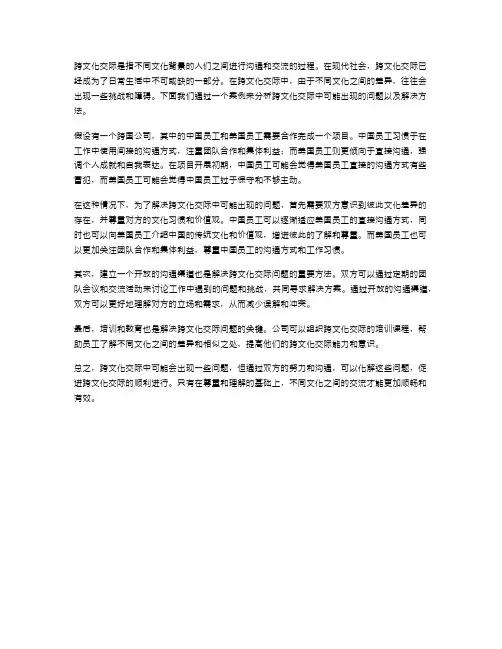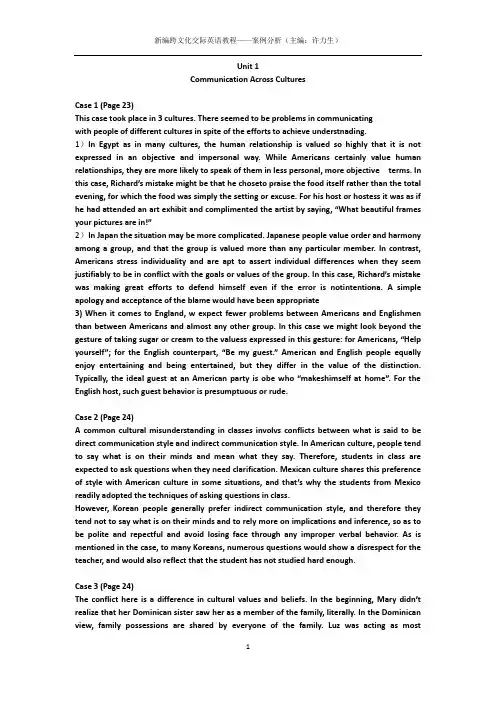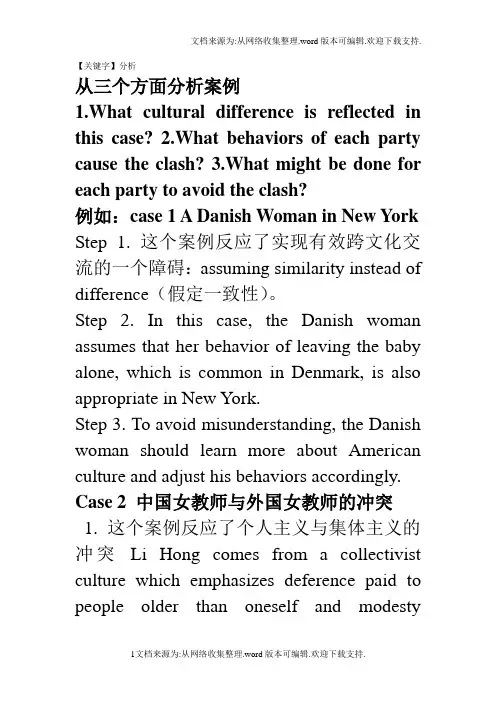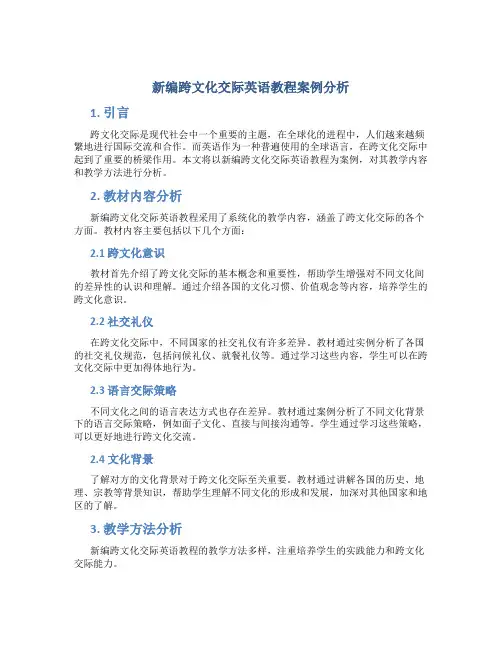新编跨文化交际案例分析
跨文化交际案例分析最新版本

跨文化交际案例例题一:内容提要:合资企业中,跨文化差异现象的存在,使得企业领导与员工的沟通具有一定的障碍,这主要是由于不同的文化背景所造成的。
面对这种文化冲突,要理性地去对待,避免感情用事,致使矛盾愈深。
案例介绍:飞利浦照明公司人力资源副总裁(美国人)与一位中国员工交谈。
中国员工的回答令副总裁难以理解,甚至不耐烦。
案例名称:《回答的方式》飞利浦照明公司某区人力资源副总裁(美国人)与一位被认为具有发展潜力的中国员工交谈。
想听听这位员工对自己今后五年的职业发展规划以及期望达到的位置。
中国员工并没有正面回答问题,而是开始谈论起公司未来的发展方向、公司的晋升体系,以及目前他本人在组织中的位置等等。
将了半天也没有正面回答副总裁的问题。
副总有些大惑不解,没等他说完已经有些不耐烦了,因为同样的事情之前已经发生了好几次。
“我不过是想知道这位员工对于自己未来五年发展的打算,想要在飞利浦做到什么样的职位罢了,可为何就不能得到明确的回答呢?”谈话结束后,副总忍不住想人力资源总监甲抱怨道。
这位老外总裁怎么这样咄咄逼人?”谈话中受到压力的员工也很苦恼。
作为人力资源总监,明白双方之间不同的沟通方式引起了隔阂,虽然他极力想双方解释,但要完全消除已经产生的问题并不容易。
以上便是整个案例,这是一个很典型的跨文化焦急的例子。
首先,我们看到这位副总裁是美国籍人,而那位员工则是中国籍。
既然出生于两个不同的国度,那他们的思维方式、生活习惯、文化程度、教育程度、文化差异等众多方面都存在着差异。
正是由于这些文化差异的存在,才使得双方在交流、沟通过程中产生一系列障碍。
其次,“中国员工并没有正面回答问题”,我们可以想象一下这位中国员工没有正面回答问题的原因。
比如说由于语言障碍、没有理解透彻美国副总裁所说话语的原意;或者说副总的文化方式让中国员工产生了误解;亦或是中国员工有意回避从正面回答……。
以上原因都知识我们的推测而已。
下面我们给出一个假设。
跨文化交际案例分析题及答案

跨文化交际案例分析题及答案案例描述在跨国公司A的一个国际会议上,来自不同国家的员工们需要共同讨论一个重要项目。
会议进行了几天,但是却一直没有取得明确的进展。
不同国家的员工语言文化差异导致了沟通障碍,讨论过程中出现了许多误解和纠纷。
公司高层深感困惑,希望找到解决这个问题的方法。
障碍分析1. 语言障碍跨国公司A的员工来自不同的国家,他们使用的是各自母语进行交流。
除了英语是共同的工作语言外,其他国别的员工使用的语言差异较大。
这种语言差异导致了语言表达的不准确和理解的模糊,使得员工们无法正常交流和理解对方。
2. 文化差异不同国家的员工具有不同的文化背景和价值观念,这导致了他们在讨论过程中产生了误解和冲突。
文化差异可以涉及到对时间观念、权力关系、政治正确性和个人自由等方面的不同理解,这些差异会影响到他们的决策方式和工作方式,导致合作的困难。
解决方案1. 提供语言支持和培训跨文化交际的第一个挑战是语言障碍。
为了解决这个问题,公司可以提供语言支持和培训,以帮助员工们提高英语或共同工作语言的能力。
这可通过组织语言培训课程,雇佣专业翻译人员或提供翻译工具等方式实现。
提供语言支持和培训可以降低语言障碍,提高员工之间的沟通效率。
2. 开展跨文化培训除了语言障碍外,文化差异也是讨论中的一个重要问题。
公司可以组织跨文化培训,帮助员工了解不同文化之间的差异,并教授他们如何在跨文化环境中进行有效的沟通和合作。
该培训可以包括介绍不同文化的价值观、信念和行为准则,以及跨文化冲突解决的技巧和策略。
通过开展跨文化培训,可以提高员工对文化差异的认识和理解,促进跨文化交际的顺利进行。
3. 引入跨文化中介人为了解决跨文化交际中的难题,公司可以考虑引入跨文化中介人。
跨文化中介人是具有跨文化交际经验和能力的人员,他们可以在员工之间进行翻译和解释,协助双方理解并解决可能出现的误解和冲突。
跨文化中介人的介入可以减少员工之间的摩擦,促进合作和理解。
跨文化交际案例分析

跨文化交际是指不同文化背景的人们之间进行沟通和交流的过程。
在现代社会,跨文化交际已经成为了日常生活中不可或缺的一部分。
在跨文化交际中,由于不同文化之间的差异,往往会出现一些挑战和障碍。
下面我们通过一个案例来分析跨文化交际中可能出现的问题以及解决方法。
假设有一个跨国公司,其中的中国员工和美国员工需要合作完成一个项目。
中国员工习惯于在工作中使用间接的沟通方式,注重团队合作和集体利益;而美国员工则更倾向于直接沟通,强调个人成就和自我表达。
在项目开展初期,中国员工可能会觉得美国员工直接的沟通方式有些冒犯,而美国员工可能会觉得中国员工过于保守和不够主动。
在这种情况下,为了解决跨文化交际中可能出现的问题,首先需要双方意识到彼此文化差异的存在,并尊重对方的文化习惯和价值观。
中国员工可以逐渐适应美国员工的直接沟通方式,同时也可以向美国员工介绍中国的传统文化和价值观,增进彼此的了解和尊重。
而美国员工也可以更加关注团队合作和集体利益,尊重中国员工的沟通方式和工作习惯。
其次,建立一个开放的沟通渠道也是解决跨文化交际问题的重要方法。
双方可以通过定期的团队会议和交流活动来讨论工作中遇到的问题和挑战,共同寻求解决方案。
通过开放的沟通渠道,双方可以更好地理解对方的立场和需求,从而减少误解和冲突。
最后,培训和教育也是解决跨文化交际问题的关键。
公司可以组织跨文化交际的培训课程,帮助员工了解不同文化之间的差异和相似之处,提高他们的跨文化交际能力和意识。
总之,跨文化交际中可能会出现一些问题,但通过双方的努力和沟通,可以化解这些问题,促进跨文化交际的顺利进行。
只有在尊重和理解的基础上,不同文化之间的交流才能更加顺畅和有效。
新编跨文化交际英语教程——案例分析(主编:许力生)Word 打印版

Unit 1Communication Across CulturesCase 1 (Page 23)This case took place in 3 cultures. There seemed to be problems in communicatingwith people of different cultures in spite of the efforts to achieve understnading.1)In Egypt as in many cultures, the human relationship is valued so highly that it is not expressed in an objective and impersonal way. While Americans certainly value human relationships, they are more likely to speak of them in less personal, more objective terms. In this case, Richard’s mistake might be that he choseto praise the food itself rather than the total evening, for which the food was simply the setting or excuse. For his host or hostess it was as if he had attended an art exhibit and compliment ed the artist by saying, “What beautiful frames your pictures are in!”2)In Japan the situation may be more complicated. Japanese people value order and harmony among a group, and that the group is valued more than any particular member. In contrast, Americans stress individuality and are apt to assert individual differences when they seem justifiably to be in conflict with the goals or values of the group. In this case, Richard’s mistake was making great efforts to defend himself even if the error is notintentiona. A simple apology and acceptance of the blame would have been appropriate3) When it comes to England, w expect fewer problems between Americans and Englishmen than between Americans and almost any other group. In this case we might look beyond the gesture of taking sugar or cream to the valuess expressed in this gesture: for Americans, “Help yourself”; for the English counterpart, “Be my guest.” American and English people equally enjoy entertaining and being entertained, but they differ in the value of the distinction. Typically, the ideal guest at an American party is obe who “makeshimself at home”. For the English host, such guest behavior is presumptuous or rude.Case 2 (Page 24)A common cultural misunderstanding in classes involvs conflicts between what is said to be direct communication style and indirect communication style. In American culture, people tend to say what is on their minds and mean what they say. Therefore, students in class are expected to ask questions when they need clarification. Mexican culture shares this preference of style with American culture in some situations, and that’s why the students from Mexico readily adopted the techniques of asking questions in class.However, Korean people generally prefer indirect communication style, and therefore they tend not to say what is on their minds and to rely more on implications and inference, so as to be polite and repectful and avoid losing face through any improper verbal behavior. As is mentioned in the case, to many Koreans, numerous questions would show a disrespect for the teacher, and would also reflect that the student has not studied hard enough.Case 3 (Page 24)The conflict here is a difference in cultural values and beliefs. In the beginning, Mary didn’t realize that her Dominican sister saw her as a member of the family, literally. In the Dominican view, family possessions are shared by everyone of the family. Luz was acting as mostDominican sisters woould do in borrowing without asking every time. Once Mary understood that there was a different way of looking at this, she would become more accepting. However, she might still experience frustration when this happened again. She had to find ways to cope with her own emotional cultural reaction as well as her practical problem (the batteries running out).Case 4 (Page 25)It might be simply a question of different rhythms. Americans have one rhythm in their personal and family relations, in their friendliness and their charities. People from other cultures have different rhythms. The American rhythm is fast. It is characterized by a rapid acceptance of others. However, it is seldom that Americans engage themselves entirely in a friendship. Their friendship are warm, but casual and specialized. For example, you have a neighbor who drops by in the morning for coffee. You see her frequently, but you never invite her for dinner------not because you don’t think she could handle a fork and a knife, but because you have seen her that morning.Therefore, you reserve your more formal invitation to dinner for someone who lives in a more distant part of the city and whom you would not see unless you extended an invitation for a special occasion. Now, if the first friend moves away and the second one moves nearby, you are likely to reserve this------see the second friend in the mornings for informal coffee meetings, and invite the first one more formally to dinner.Americans are, in other words, guided very often by their own convenience. They tend to make friends rapidly, and the y don’t feel like it necessary to go to a great amount of trouble to see friends often when it becomes inconvenient to do so, and usually no one is hurt. But in similar circumstances, people from many other cultures would be hurt very deeply.Unit 2Culture and CommunicationThe analysis of this case: (Page 38)The least three things among the following Tom did that were regarded to be impolite:b. Tom opens the gift as soon as he is presented with it.d. Tom does not make a second offer of drinks when they refuse the first.e. Tom talks about the cost of living in the U.S.A.f. Tom does not ask them to stay longer when they say they must be leaving.g. Tom does not go out to see them off.Case 5 (Page 60)Analysis: The Chinese guide should refuse the first offer because he is obeying the Chinese rules for communication. We Chinese are modest, polite and well-behaved. Maybe the guide is waiting for a second or third offer of beer, but he doesn’t know the reasons behind the rule in American culture that you do not push alcoholic beverages on anyone. A person may not drink for religious reasons, he may be a reformed alcoholic, or he may be allergic. Whatever the reason, you donot insist on offering alcohol. So they politely never made a second offer of beer to the guide.Case 6 (Page 61)When a speaker says something to a hearer,there are at least three kinds of meanings involved:utterance meaning, the speaker’s meaning and the hearer’s meaning. In the dialogue, when Litz asked how long her mother-in-law was going to stay, she meant that if she knew how long she was going to saty in Finland, she would be able to make proper arrangements for her, such as taking her out to some sightseeing. However, her mother-in-law took Litz’s question to mean “Litz does not want me to saty for long”. From the Chinese point of view, it seems inappropriate for Litz to ask such a question just two days after her mother-in-law’s arrival. If she has to ask the question, it would be better to ask some time later and she should not let her mother-in-law hear it.Case 7 (Page 62)Analysis:Keiko insists on giving valuable gifts to her college friends, because in countries like Japan, exchanging gifts is a strongly rooted social tradition. Should you receive a gift, and don’t have one to offer in return, you will probably create a crisis. If not as serious as a crisis, one who doesn’t offer a gift in return may be considered rude or impolite. Therefore, in Japan, gifts are a symbolic way to show the care, respect, gratitude and further friendship. Keiko’s college friends would rather round up some of the necessary items and they are willing to have her use them. They really expected nothing from her. For in America, people donate their used household items to church or to the community. They would never consider these old items as gifts to Keiko. So Keiko’s valuable gifts have made her American friends feel uncomfortableCase 8 (Page 62)When the Chinese girl Amy fell in love with an American boy at that time, it seems that she preferred to celebrate Chritmas in the American way, for she wanted very much to appear the same as other American girls. She did not like to see her boyfriend disappointed at the “shabby” Chinese Christmas. That’s why she cried when she found out her parents had invited the minister’s family over for the Christmas Eve dinner. She thought the menu for the Chritmas meal created by her mother a strange one because there were no roast turkey and sweet potatoes but only Chinese food. How could she notice then the food chosen by her mother were all her favorites?From this case, we can find a lot of differences between the Chinese and Western cultures in what is appropriate food for a banquet, what are good table manners, and how one should behave to be hospi table. However, one should never feel shame just because one’s culture is different from others’. As Amy’s mother told her, you must be proud to be different, and your only shame is to have shame.Unit 3Cultural DiversityCase 7 (Page 76)Between friends there is inevitably a kind of equality of give-and-take. But in different cultures, people view this differently. In Chinese culture,friendships develop slowly because they are built to last. We Chinese prefer the saying “A friend indeed is a friend in need.” And we never refuse theasking for help from a friend. We never forget the timely help by a friendwhen we are on the rocks. But In American culture, they view this in adifferent way. Once helped, they offer their help only once. That’s whyJackson said that Mr. Zhao was asking too much. In their view, friendshipsare based on common interests.1 Different Lands, Different Friendships (P 77)●French Friendships●German Friendships●English Friendships●Chinese Friendships (见补充材料)●American Friendships (见补充材料)补充案例(American Friendship)Two mothers, Carmen and Judy, are talking to each other at a park while their children are playing together in the sand.Caemen: Hi, Judy.Judy: Hi, Carmen. How are you?Carmen: Fine. I’m glad to see that our children like to play together.Judy: Yeah, me too. I remember just a month ago they weren’tsharing their toys.Carmen: Now it looks like they’re enjoying each other.Judy: Finally! Maybe we could get together at each other’s ho usessometime. I’m sure the kids would enjoy that.Carmen: Sure. That’d be nice.Judy: Well, let’s do it soon.Carmen: O.K.(Judy and Carmen continue to talk while their children play.) Case AnalysisJudy and Carme n are not real friends. They don’t want to get together, really. They once met each other a month ago. Americans sometimes make general invitation like “Let’s get together sometimes.” Often this is just a way to be friendly. It is not always a real invit ation. If they’d like to set a specific (exact) time, that means a real offer.2 Family Structure (P83)●Chinese Family●Filipinos Family●Vietnamese Family●Japanese Family (See Case 9 and Case 10)●Latin American FamilyCase 9 (Page 96)Traditional Japanese respect their elders and feel a deep sense of duty toward them. The elders in traditional Japanese families are typically overpowered. So the grandfather seemed to be an absolute authority for the young chairman. In Japanese culture challenging or disagreeing with eilder’s opinions would be deemed as being disrespectful. That is why the young chairman said nothing but just nodded and agreed with his grandfather. And it results in the Japanesecompany’s withdrawal from the negotiations concerning a relationship with Phil’s company a week later.Case 10 (Page 97)In Japan, a company is very much like a big family, in which the manager will take care of the employees and the employees are expected to cevote themselves to the development of the company and, if it is necessary, to sacrifice their own interests for the interests of the company. But to the French, a company is just a loosely-knit social organization wherein individuals are supposed to take care of themselves and their families. And the family is the number one priority, which is unlike the Japanese model “not involving females and the right to decide by dominant male”.Case 11 (Page 97)In most cultures, an apology is needed when an offence or violation of social norms has taken place. To many Westerners, Japanese apologize more frequently and an apology in Japanese does not necessarily mean that the person is acknowledging a fault. To many Japanese, Westeners may seem to be rude just because they do not apologize as often as the Japanese would do. In this case, the atitude of the Australian student’s parents is shocking the Japanese but will be acceptable in an English-speaking society, for the student is already an adult and can be responsible for her own deeds.Case 12 (Page 98)In this case, it seems that the Chinese expectation were not fulfilled. First, having two people sharing host responsibilities could be confusing to the Chinese.Second, in China, it is a tradition for the host to offer a welcome toast at the beginning of the meal. By not doing so, the Canadian might be thought rude. The abrupt departure of the Chinese from the banquet was probably an indication that they were not pleased with the way they were treated. The Canadians’ lack of understanding of the C hinese culture would be a problem in their dealing with the visiting delegation.。
【分析】跨文化交际案例分析

【关键字】分析从三个方面分析案例1.What cultural difference is reflected in this case?2.What behaviors of each party cause the clash?3.What might be done for each party to avoid the clash?例如:case 1 A Danish Woman in New York Step 1. 这个案例反应了实现有效跨文化交流的一个障碍:assuming similarity instead of difference(假定一致性)。
Step 2. In this case, the Danish woman assumes that her behavior of leaving the baby alone, which is common in Denmark, is also appropriate in New York.Step 3. To avoid misunderstanding, the Danish woman should learn more about American culture and adjust his behaviors accordingly. Case 2 中国女教师与外国女教师的冲突1. 这个案例反应了个人主义与集体主义的冲突Li Hong comes from a collectivist culture which emphasizes deference paid to people older than oneself and modestydisplayed on the part of the young. Maggy comes from an individualistic culture which values assertiveness and free expression of feelings.2.3.Case 3Susan Wood, a young American mother of a four-year-old boy, came to China for the first time. She wrote a letter to her parents for help. Dear Dad and Mom,I don’t feel happy in China. I am scared by how the Chinese treat Tommy. Tommy is already four years old. Whenever I take him outside, a lot of Chinese w hom I don’t know would fondle him, touching, patting, hugging or even kissing him. It seems that the Chinese are treating Tommy as a pet. I think they are very rude. What should I do?Best wishes,Susan1.This case reflects different attitudes towardsone stuff of people from different cultural backgrounds.此文档是由网络收集并进行重新排版整理.word可编辑版本!。
新编跨文化交际英语教程案例分析

新编跨文化交际英语教程案例分析1. 引言跨文化交际是现代社会中一个重要的主题,在全球化的进程中,人们越来越频繁地进行国际交流和合作。
而英语作为一种普遍使用的全球语言,在跨文化交际中起到了重要的桥梁作用。
本文将以新编跨文化交际英语教程为案例,对其教学内容和教学方法进行分析。
2. 教材内容分析新编跨文化交际英语教程采用了系统化的教学内容,涵盖了跨文化交际的各个方面。
教材内容主要包括以下几个方面:2.1 跨文化意识教材首先介绍了跨文化交际的基本概念和重要性,帮助学生增强对不同文化间的差异性的认识和理解。
通过介绍各国的文化习惯、价值观念等内容,培养学生的跨文化意识。
2.2 社交礼仪在跨文化交际中,不同国家的社交礼仪有许多差异。
教材通过实例分析了各国的社交礼仪规范,包括问候礼仪、就餐礼仪等。
通过学习这些内容,学生可以在跨文化交际中更加得体地行为。
2.3 语言交际策略不同文化之间的语言表达方式也存在差异。
教材通过案例分析了不同文化背景下的语言交际策略,例如面子文化、直接与间接沟通等。
学生通过学习这些策略,可以更好地进行跨文化交流。
2.4 文化背景了解对方的文化背景对于跨文化交际至关重要。
教材通过讲解各国的历史、地理、宗教等背景知识,帮助学生理解不同文化的形成和发展,加深对其他国家和地区的了解。
3. 教学方法分析新编跨文化交际英语教程的教学方法多样,注重培养学生的实践能力和跨文化交际能力。
3.1 案例分析教材采用了案例分析的教学方法,通过真实的跨文化交际案例来引导学生思考和讨论。
这种方法可以帮助学生将所学的知识应用到实际情境中,提高他们的实践能力。
3.2 分组讨论教材中安排了一些跨文化交际话题,要求学生进行分组讨论。
通过小组合作,学生可以在团队中相互交流和学习,培养他们的合作能力和跨文化交际能力。
3.3 角色扮演为了提高学生的语言交际能力和应对跨文化情境的能力,教材中设置了一些角色扮演的活动。
学生可以扮演不同国家的人物,通过模拟真实情境来学习和实践跨文化交际技巧。
跨文化交际案例分析万能模板
跨文化交际案例分析万能模板案例背景跨文化交际是指在不同文化背景下进行的交流和互动。
由于不同文化具有不同的价值观、信仰、习俗和行为规范,跨文化交际往往面临着挑战和困难。
本文将通过分析一个跨文化交际案例,探讨跨文化交际中常见的问题,并提供解决问题的方法,以此为参考,帮助人们更好地进行跨文化交际。
案例描述案例中,A是中国人,B是美国人。
他们是在一家国际公司工作的同事。
一天,在一个重要会议上,A提出了一个新的想法,但没有得到B的支持,甚至遭到了反对。
A感到困惑和失望,并对B的态度感到不解。
问题分析1.语言障碍:A和B来自不同的文化背景,使用不同的母语。
这可能导致他们在交流中出现理解的困难,甚至存在翻译误解的可能性。
2.价值观冲突:A和B来自具有不同价值观的文化,他们对问题的看法和解决方法可能存在差异。
这造成了他们在会议上的分歧。
3.社交礼节:A和B在社交礼节方面可能存在差异。
比如在会议上,B的反对可能是基于不同的文化背景下对表达意见的方式和场景的理解。
解决方法1.主动沟通:A和B应该积极主动地沟通,充分交流彼此的意见和想法。
他们可以约定一个合适的时间,面对面地沟通,以确保双方对对方的意思有清晰的理解。
2.尊重他人文化:A和B应该尊重彼此的文化差异。
他们可以通过学习对方的文化,了解他人的价值观和习俗,以更好地理解和包容对方的观点。
3.寻求共同利益:A和B可以寻找问题的共同利益,以此为基础来达成共识和解决分歧。
他们可以探讨对方的顾虑并提出解决方案,以达成双赢的结果。
4.适应交流方式:A和B可以适应对方的交流方式。
他们可以根据对方的习惯和文化特点,选择合适的表达方式和场景,以减少误解和冲突的可能性。
结论跨文化交际虽然存在挑战和困难,但通过主动沟通、尊重他人文化、寻求共同利益和适应交流方式等方式,我们可以更好地解决问题,建立跨文化交际的良好关系。
希望通过这个万能模板,能帮助更多人在跨文化交际中更加成功和顺利。
跨文化交际案例及分析(精选5篇)
跨文化交际案例及分析(精选5篇)跨文化交际案例及分析范文第1篇[关键词]跨文化外语教学案例分析大同学跨文化交际本领一、跨文化英语教学现状分析就我国的外语教学现状而言,高一虹(2023:28)指出,现有的跨文化交际本领培育模式都有肯定局限。
行为中心的培育模式,只关注交际行为本身和交际结果,执着于实在目标,但在我们一般性的大学教育中,很难确定同学将来可能与之打交道的目的文化,因此也很难像对特定出国人员进行培训那样对同学实施有较强针对性的训练;学问中心模式,则集中于认知层面,重要向同学灌输有关文化学问,但难以让同学产生切身体验,而且还不适用于处理文化的多样性和动态性,传授文化学问简单变成“定型”(stereotype),反而不利于跨文化交际本领向较高层次进展。
另外,我们的教学大纲设计和教学实践往往缺乏充足的开放性,没有给同学较多面对问题和独立解决问题的机会。
因此在跨文化外语教学中,需要依据跨文化交际本领框架,提高同学使用语言的正确性的同时还要帮忙其提高言语行为的得体性。
在近年来对跨文化交际本领框架的浩繁讨论中,笔者认为杨盈、庄恩平(2023)提出的由全球意识、文化调适、文化学问和交际实践四大本领系统构成的外语教学跨文化交际本领框架,符合教学大纲和教学实践的要求,具较强可行性。
二、案例分析在跨文化英语教学中的作用目前跨文化英语教学普遍采纳的方法重要包括背景学问导入、文化内涵探究、案例分析、角色扮演及情景仿照、实例搜索等。
案例分析教学中将不同文化背景的语言特色、风土人情、历史事件和现实冲突等素材呈现于同学面前,是跨文化学问、意识、思维和交际本领的综合训练过程,能帮忙同学达到学习外语语言技能与培育跨文化交际本领有机结合的目的。
在谈到案例教学法时,陈建平(2023)强调:“案例是为适应特定的教学目的而编写的”,教学过程重要是“同学之间的讨论和辩论”,教学目的重要是“培育同学的本领”。
上述特点,使案例教学能很好适用于跨文化外语教学,它对培育本领的重视大过取得学问,成为语言文化学问向跨文化本领变化的有效途径。
跨文化交际案例分析
案例三:非语言交际行为的误解
情况描述
在一次国际晚宴中, 一位美国客人和一位 日本客人之间的社交 礼仪产生了差异。美 国客人习惯于直接、 热情的礼仪,而日本 客人则更注重谦虚和 尊重。这导致双方在 晚宴中的互动出现了 尴尬和误解
案例三:非语言交际行为的误解
问题分析
这个案例中的问题主要是由社交礼仪的差异引起的。美 国客人和日本客人的社交礼仪存在明显差异,这种差异 可能导致双方在互动中产生误解和尴尬
案例三:非语言交际行为的误解
解决方案
为了解决这个问题,首先需要认识到这种社 交礼仪的差异,并尊重彼此的礼仪习惯。美 国客人可以尝试更理解日本客人的谦虚和尊 重,而日本客人也可以尽可能适应美国客人 的直接和热情。双方可以通过了解彼此的社 交礼仪,找到一个共同的解决方案,以达到 和谐的互动
PART 4
案例五:食物与文化的关系
4
案例五:食物与文化的关系
情况描述
在一个国际家庭聚会 中,来自不同国家的 亲戚们在一起共享美 食。然而,由于食物 与文化的关系不同, 一些食物在某些国家 是受欢迎的,而在其 他国家却被视为禁忌 。这导致了一些尴尬 和误解
案例五:食物与文化的关系
问题分析
这个案例中的问题主要是由食物与文化的关系引起的。 来自不同国家的亲戚们对食物的认知和文化背景存在差 异,这种差异可能导致在共享美食时产生尴尬和误解
案例一:语言与文化差异的处理
解决方案
为了解决这个问题,首先需要认识到这种语 言与文化差异的存在,并尊重彼此的交际风 格。英国员工可以尝试更能明确表达 自己的意见。此外,双方还可以通过提高彼 此的语言能力,更好地理解和尊重对方的文 化背景
PART 2
案例二:价值观与文化冲突的解决
跨文化交际案例分析
跨文化交际案例分析随着全球化的发展,跨文化交际变得越来越重要。
无论是在商务领域还是在社交领域,人们都需要与不同文化背景的人交流和合作。
然而,由于文化差异的存在,跨文化交际可能会面临一些挑战。
本文将通过分析一个真实的跨文化交际案例,探讨其中的问题和解决方案。
案例背景:John是一个美国的销售人员,他的公司决定进军中国市场。
为了开拓新业务,John前往中国与一家当地的公司进行商务谈判。
然而,由于两国文化的差异,John在交流过程中遇到了一些问题。
问题一:礼节和尊重在中国文化中,尊重和礼节非常重要。
然而,John在交谈中没有注意到这一点,只关注自己的目标和利益。
他没有在一开始表示感谢和尊重,也没有提到他是代表公司的,并且在对方发言时经常打断。
解决方案:在跨文化交际中,了解对方文化的礼节和习惯非常重要。
John应该在交谈开始时表示感谢和尊重,并明确表明自己的身份和目标。
他还应该尊重对方发言的权利,避免打断对方。
问题二:语言和沟通John并不懂中文,而对方的英文水平也有限。
在交流中,他们经常遇到理解和沟通的困难。
John使用了一些俚语和口语,对方很难理解。
另外,他们还遇到了一些语言使用上的误解和误译。
解决方案:语言是跨文化交际的重要因素之一。
在这种情况下,John可以使用简单的英语词汇和句子,避免使用俚语和口语。
另外,使用简洁明了的语言,避免使用复杂的词汇和长句子,有助于加强理解和沟通。
问题三:谈判风格和冲突处理中国和美国在谈判风格和冲突处理上存在一些差异。
John采取了直接和坦率的方式,直接表达自己的意见,并试图争取自己的利益。
然而,在中国文化中,人们通常更加注重保持面子和和谐,避免直接表达意见和产生冲突。
解决方案:了解对方的谈判风格和冲突处理方式对于跨文化交际至关重要。
John可以采取一种更加温和和委婉的方式,尊重对方的面子和和谐。
他可以提出一些建议,并鼓励对方发表意见,以达到双方都满意的结果。
总结:通过上述案例的分析,我们可以看到在跨文化交际中可能会出现的一些问题,以及解决这些问题的方法。
- 1、下载文档前请自行甄别文档内容的完整性,平台不提供额外的编辑、内容补充、找答案等附加服务。
- 2、"仅部分预览"的文档,不可在线预览部分如存在完整性等问题,可反馈申请退款(可完整预览的文档不适用该条件!)。
- 3、如文档侵犯您的权益,请联系客服反馈,我们会尽快为您处理(人工客服工作时间:9:00-18:30)。
Unit 5Culture and Verbal CommunicationCase 17When these two men separate, they may leave each other with very different impressions.Mr Richardson is very pleased to have made the acquaintance of Mr Chu and feels they have gotten off to a very good start. They have established their relationship on a first-name basis and Mr Chu‘s smile seemed to indicate that he will be friendly and easy to do business with. Mr Richardsonis particularly pleased that he had treated Mr Chu with respect for his Chinese background by calling him Hon-fai rather than using the western name, David, which seemed to him an unnecessary imposition of western culture.In contrast, Mr Chu feels quite uncomfortable with Mr Richardson. He feels it will be difficultto work with him, and that Mr Richardson might be rather insensitive to cultural differences. He is particularly bothered that, instead of calling him David or Mr Chu, Mr Richardson used his given name, Hon-fai, the name rarely used by anyone, in fact. It was this embarrassment which caused himto smile. He would feel more comfortable if they called each other Mr Chu and Mr Richardson. Nevertheless, when he was away at school in North America he learned that Americans feel uncomfortable calling people Mr for any extended period of time. His solution was to adopt awestern name. He chose David for use in such situations.Case 18Even if the American knew Urdu, the language spoken in Pakistan, he would also have to understand the culture of communication in that country to respond appropriately. In this case, hehad to say ―No at least three times.In some countries, for instance, the Ukraine, it may happen that a guest is pressed as many as seven or eight times to take more food, whereas in the UK it would be unusual to do so more than twice. For a Ukrainian, to do it the British way would suggest the person is not actually generous. Indeed, British recipients of such hospitality sometimes feel that their host is behaving impolitelyby forcing them into a bind, since they run out of polite refusal strategies long before the Ukrainian host has exhausted his/her repertoire of polite insistence strategies.Case 19Talking about what‘s wrong is not easy for people in any culture, but people in high-context countries like China put high priority on keeping harmony, preventing anyone from losing face, and nurturing the relationship. It seems that Ron Kelly had to learn a different way of sending message when he was in China. At home in Canada he would have gone directly to the point. But in China, going directly to the problem with someone may suggest that he or she has failed to live up to his or her responsibility and the honor of his or her organization is in question. In high-context cultures like China, such a message is serious and damaging. In low-context cultures, however, the tendency isjust to ―spit it out, to get it into words and worry about the result later. Senders of unwelcome messages use objective facts, assuming, as with persuasion, that facts are neutral, instrumental, and impersonal. Indirectness is often the way members of high-context cultures choose to communicate about a problem.Case 20It seems that the letters of request written in English as well as in Chinese by Chinese peopleare likely to preface the request with extended face-work. To Chinese people, the normal and polite way to form a request requires providing reasons that are usually placed before the requests. Of course, this is just the inverse of English conventions in which requests are fronted without much face-work. In the view of the English-speaking people, the opening lines of Chinese requests and some other speech acts do not usually provide a thesis or topic statement which will orient the listener to the overall direction of the communication. Worst of all, the lack of precision and the failure to address the point directly may lead to suspicions that the Chinese speakers are beating around the bush. To them, the presence of a clear and concise statement of what is to be talked about will make the speech more precise, more dramatic, and more eloquent.However, the Chinese learning and using English in communication may find it difficult tocome to terms with the common English tendency to begin with a topic statement. In the Chinese culture, stating one‘s request or main point at the beginning would make the person seem immodest,pushy, and inconsiderate for wanting things. If your speech gives others the impression that you are demanding something, you would lose face for acting aggressively and not considering the others.Thus you‘d be hurting people by claiming something for yourself.In such a situation, it is usually considered a smart strategy if you carefully delineate the justifications that will naturally lead to your request or argument. Therefore, instead of stating their proposition somewhere in the beginning and then proceeding to build their case, Chinese people often first establish a shared context with which to judge their requests or arguments. Only after carefully prefacing them with an avalanche of relevant details, as if to nullify any opposition, will they present the requests or arguments.Unit 6Culture and Nonverbal CommunicationCase 21Sometimes our best intentions can lead to breakdowns in cross-cultural communication. For example, one of the very common manners of touching --- handshaking --- may result in conflictwhen performed with no consideration of cultural differences. Among middle-class North American men, it is customary to shake hands as a gesture of friendship. When wanting to communicate extra friendliness, a male in the United States may, while shaking hands, grasp with his left hand hisfriend‘s right arm. However, to people of Middle Eastern countries, the left hand is profane and touching someone with it is highly offensive. Therefore, in Vernon‘s eyes, Kenneth was actually an extremely offensive message to him.Case 22In Puerto Rican culture, as in some other Latin American and Eastern cultures, it is not right fora child to keep an eye-contact with an adult who is accusing him or her, while in the United States, failing of meeting other person‘s eye accusing him or her would be taken as a sign of guiltiness. Asthe principal knew little about this cultural difference in using eye-contact, he decided that the girl must be guilty. Generally speaking, avoiding eye-contact with the other(s) is often considered as an insult in some cultures, but may signify respect for authority and obedience in other cultures.Case 23Just like smile, laughing does not always serve the same function in different cultures. Interestingly, for us Chinese, laughing often has a special function on some tense social occasions. People may laugh to release the tension or embarrassment, to express their concern about you, their intention to put you at ease or to help you come out of the embarrassment. In this case, the people there were actually wishing to laugh with the American rather than laugh at her. Their laughing seemed to convey a number of mess ages: don‘t take it so seriously; laugh it off, it‘s nothing; such things can happen to any of us, etc. Unfortunately the American was unaware of this. She thoughtthey were laughing at her, which made her feel more badly and angry, for in her culture laughing on such an occasion would be interpreted as an insulting response, humiliating and negative.Case 24It is obvious that there exists some difference between the British and Germans in their use oftouch. The lack of touch that seems to be natural in Britain may be considered strange by Germans. What is required (in this case, shaking hands with each other) in one country could be taken as unnecessary in another.The appropriateness of contact between people varies from country to country. Figures from a study offer some interesting insight into this matter. Pairs of individuals sitting and chatting incollege shops in different countries were observed for at least one hour each. The number of timesthat either one touched the other in that one hour was recorded, as follows: in London, 0; in Florida, 2; in Paris, 10; in Puerto Rico, 180. These figures indicate that touch is used very differently indifferent cultures.。
